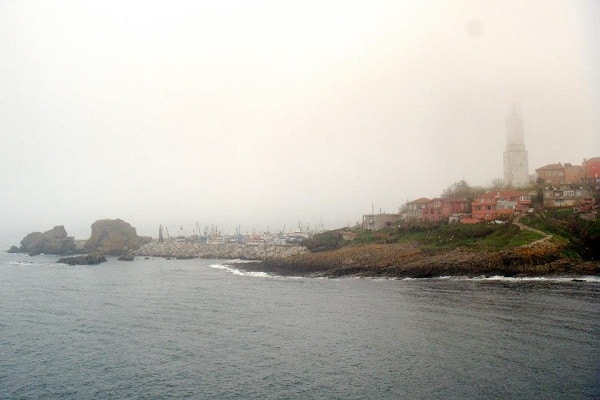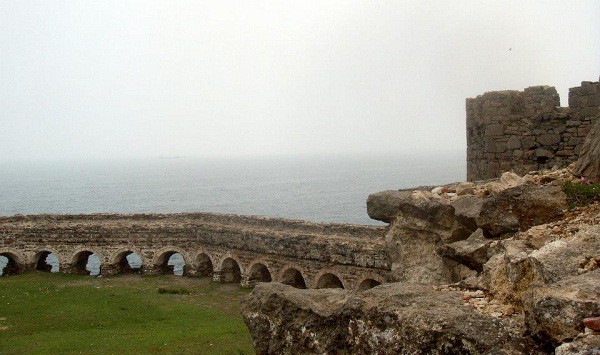Feeling as if in a dream, I watched the thick fog swirl around on the forest floor as we raced through a breathtaking canopy of deep green on the Rumeli Feneri Yolu. The color of the trees, much like everything else, looked richer from the rain the night before. Determined to escape the crowds and stresses of metropolitan life, my girlfriends and I set our compasses north to Sarıyer for a wintery Sunday morning getaway. Sharing a love of “time travel,” we were immediately intrigued with the idea of exploring some of the city’s ruins, which led us to the village of Rumeli Feneri. Surprisingly devoid of high-rise buildings or traffic, Rumeli Feneri is a quiet place in a veritable sea of noise.

Located in the northernmost tip of the European side of Istanbul, Rumeli Feneri rests at the meeting point between the Bosphorus and the Black Sea. Here you can enjoy a spectacular one hundred eighty degree view of them both. Home to a population of roughly 2,040 people, we mentioned to each other that we felt as if we had been transported back to our comparably small hometowns. The village also offers a variety of activities, like sampling fresh mussels and sea bass at Mendirek Balık Restaurant, swimming at the Golden Beach Club (although sadly not something we could try out), and touring historical sites dating from the 17th and 19th centuries. Even cyclists would be thrilled to visit — there are bike paths in the area, which you can research online to ensure the most picturesque route (links in Turkish).
A lifelong fascination with history immediately lead us to the harbor where we caught a glimpse of the Rumeli Feneri lighthouse. Constructed in 1856, the lighthouse is said to have been built by the French in order to ensure safe passage for French and British ships entering the Bosphorus from the Black Sea during the Crimean War. The lighthouse is still operational to this day. Additionally, the lighthouse is home to what is believed to be the tombstone of Sari Saltuk Baba, a 13th century dervish who is best known in popular culture as a legendary saint. Little factual information is known of the life of Sari Saltuk Baba — years of speculation on the part of historians and his legendary status have shrouded his life in mystery. His tombstone in Rumeli Feneri is just one of 12 alleged grave sites, many of which serve as places of pilgrimage.

Passing through Rumeli Feneri, we began to walk the small, well-traveled dirt road that leads to the adjacent peninsula. Taking in the sounds of the sea and the gulls, we began to make out a structure in the distance. At the road’s end, a plot of land serves as a parking lot accompanied by a man with a cart selling tea, water, and Turkish rice. Farther up on the shore of the peninsula, standing tall overlooking the sea, are the large ruins of a once magnificent Ottoman-era castle. Built in the 17th century by Sultan Murad IV, the Rumeli Feneri castle was placed in a location that would maximize its function as a hub for surveillance and gathering intelligence. Next to the castle, one can see the ruins of a watchtower whose history and origin to this day remain unknown.
Rumeli Feneri castle is just one of several fortresses positioned on the coast (Rumeli Hisarı and Anadolu Hisarı are two prominent examples) which were gradually built up throughout the centuries. The fortresses served as a line of defense, and protected the Golden Horn from invasion. It is even said a large chain was pulled across the Bosphorus between Rumeli Hisarı and Anadolu Hisarı to block ships from entering and exiting.
In its current condition, the grounds of the Rumeli Feneri castle remain largely unmaintained and unprotected. With the recent construction of Istanbul’s 3rd bridge in the neighboring village of Garipçe underway, it remains to be seen what changes these small villages will encounter as the area is opened up to the larger city. In stark contrast to the everyday hustle of Istanbul’s city center, the little fishing village of Rumeli Feneri stands as a reminder of a simpler life. A life that many visitors from metropolitan Istanbul may not know exists.
How to Get There: From Hacıosman Metro Station in Sarıyer, take the IETT 150 – Rumeli Feneri bus.
Sarah Juptner is a contributor to Yabangee
[geo_mashup_map]











What a lovely day trip…
Apparently it is not that far from my home but I do not know about it. What a shame! Should check it soon 🙂